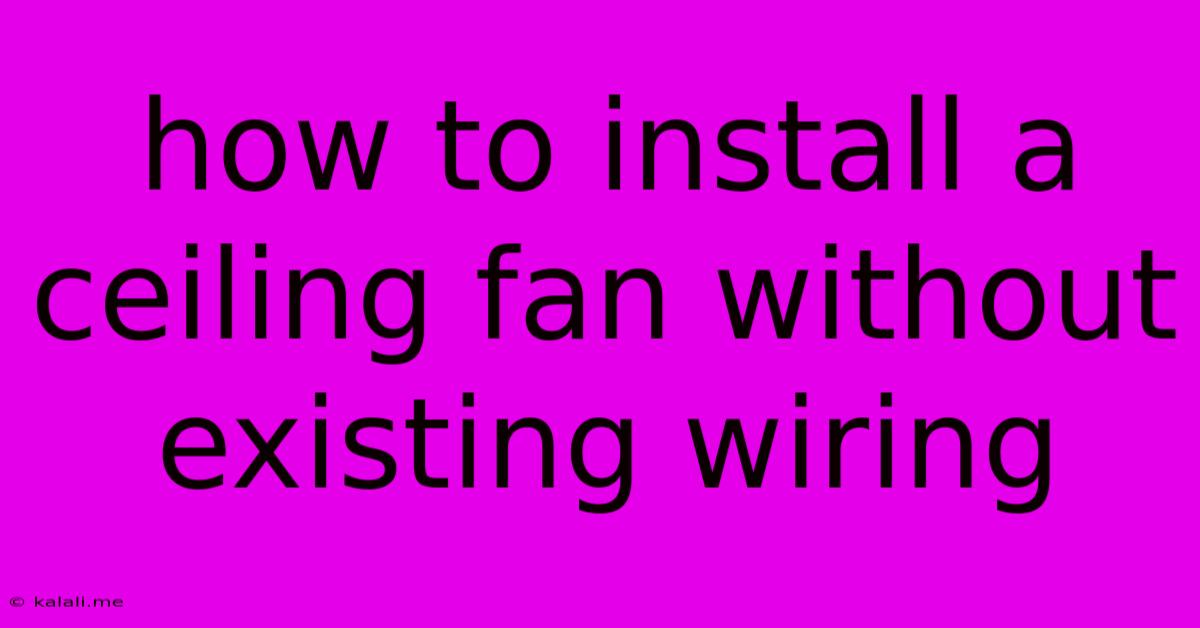How To Install A Ceiling Fan Without Existing Wiring
Kalali
Jun 08, 2025 · 4 min read

Table of Contents
How to Install a Ceiling Fan Without Existing Wiring: A Comprehensive Guide
Meta Description: Installing a ceiling fan where no wiring exists requires careful planning and electrical expertise. This guide details the process, from assessing your needs to safely connecting the wiring, ensuring a safe and functional installation.
Adding a ceiling fan to a room without existing wiring might seem daunting, but with the right preparation and a bit of electrical knowledge, it's a manageable DIY project. This comprehensive guide walks you through the entire process, from initial planning to the final installation, ensuring a safe and effective result. Remember, safety is paramount. If you're uncomfortable working with electricity, consult a qualified electrician.
1. Assessing Your Needs and Planning the Installation
Before you even think about grabbing your tools, you need a solid plan. This includes:
- Determining the type of fan: Choose a ceiling fan suitable for your room size and style. Consider factors like blade size, motor power, and features like light kits or remote controls.
- Choosing the right location: Select a spot that maximizes airflow and avoids obstructions like doorways or furniture. Ensure the ceiling joist is strong enough to support the fan’s weight.
- Planning the wiring route: This is crucial. You'll need to determine the best path for the new wiring from your electrical panel to the fan location. Consider minimizing the visible wiring and avoiding obstacles in your walls and ceilings. Keep the wiring away from plumbing and heating ducts.
- Gathering necessary materials: Besides the ceiling fan itself, you'll need wiring (Romex cable), electrical boxes (old work boxes for ceiling installation are recommended), wire connectors, a voltage tester, fish tape or wire snake, electrical tape, mounting hardware, and appropriate safety gear (safety glasses, gloves).
2. Turning Off the Power and Preparing the Electrical Panel
This is the most critical step. Before touching any wiring, turn off the power at your electrical panel to the circuit you'll be using. Double-check with a voltage tester to ensure the power is completely off.
- Adding a new circuit breaker: You'll likely need to add a dedicated circuit breaker to your panel for the new ceiling fan. This requires some electrical knowledge or professional help, depending on your comfort level and local regulations. Consult a qualified electrician if unsure.
- Running the wiring: Carefully run the Romex cable from your electrical panel to the chosen ceiling location. This often involves running the wire through the attic or wall cavities, requiring careful navigation to avoid damage to existing structures. Fish tape or a wire snake can be extremely helpful for this step. Secure the cable appropriately along the route to prevent it from sagging or becoming damaged.
3. Installing the Electrical Box and Mounting the Fan
- Installing the electrical box: Securely mount the old work electrical box in the ceiling, ensuring it's level and firmly attached to a ceiling joist.
- Connecting the wires: Carefully connect the wires from the Romex cable to the wires of your ceiling fan, following the wiring diagram provided with your fan. Use wire connectors to create secure connections. Remember to match the colors correctly: black to black (hot), white to white (neutral), and bare copper to bare copper (ground). Ensure all connections are tight and secure.
- Mounting the fan: Attach the ceiling fan mounting bracket to the electrical box. Carefully follow the manufacturer's instructions for mounting the fan to the bracket.
4. Testing and Finishing
- Turn the power back on: Once all connections are made, carefully turn the power back on at the electrical panel.
- Test the fan: Test the fan to ensure it's working correctly. Check all speeds and the light (if applicable).
- Finishing touches: Install the fan blades, light kit (if applicable), and any other accessories.
Important Safety Precautions
- Always turn off the power before working with electricity.
- Use a voltage tester to confirm the power is off.
- Wear appropriate safety gear.
- Follow all manufacturer’s instructions carefully.
- If you're uncomfortable with any aspect of this project, consult a qualified electrician.
Installing a ceiling fan without existing wiring is a project best tackled with careful planning and a solid understanding of electrical safety. By following these steps and prioritizing safety, you can successfully add a functional and stylish ceiling fan to your home. Remember, seeking professional assistance when needed is always a smart choice.
Latest Posts
Latest Posts
-
Can You Use Duct Tape On Dryer Vent
Jun 08, 2025
-
Recruiters Want To Stay In Control Of The Phone Conversations
Jun 08, 2025
-
How Long Can Fresh Eggs Stay Unrefrigerated
Jun 08, 2025
-
How To Get Charcoal Flavor On A Gas Grill
Jun 08, 2025
-
What Is Gin 13 Game Card Game
Jun 08, 2025
Related Post
Thank you for visiting our website which covers about How To Install A Ceiling Fan Without Existing Wiring . We hope the information provided has been useful to you. Feel free to contact us if you have any questions or need further assistance. See you next time and don't miss to bookmark.